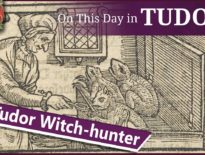On this day in history, 24th December 1604, Christmas Eve, Sir Thomas Cornwallis, Comptroller of the household of Mary I and member of Parliament, died at about the age of eighty-six.
Cornwallis had been active putting down rebellion in 1549 and during the succession crisis of July 1553 swapped sides at just the right time, recanting his proclamation for Jane as queen and proclaiming for Mary instead, He was rewarded for this when Mary came to the throne.
Of course, he wasn't so much a favourite in the reign of Elizabeth I, but a friendship with a man close to Elizabeth may have helped him escape trouble.
Find out more about Sir Thomas Cornwallis in today's talk.
Also on this day in Tudor history, 24th December 1545, Christmas Eve, King Henry VIII made his final speech to Parliament. The king was concerned about the religious divisions in his realm and so chastised the Lords and Commons for their disagreements, and also the clergy for provoking this discord. I shared some of his speech, which included the wonderful words mumpsimus and sumpsimus, in last year’s video:
Today is obviously Christmas Eve, so do check out the video Teasel and I did on one of the Tudor traditions associated with Christmas Eve – the Yule Log:
Transcript:
On this day in history, 24th December 1604, Sir Thomas Cornwallis, Comptroller of the household of Mary I and member of Parliament, died at about the age of eighty-six.
Cornwallis was active in putting down Kett's Rebellion in 1549, and in 1553, after originally proclaiming Lady Jane Grey as Queen in Ipswich, he swapped sides and swore allegiance to Mary I.
Let me tell you a bit more about this Tudor man…
Suffolk man Sir Thomas Cornwallis was born in around 1518/19 and was the eldest son of Sir John Cornwallis and his wife, Mary Sulyard. Sir John Cornwallis served as steward to the household of Prince Edward, the future Edward VI, from 1538 to 1544.
In 1539, when he was about 20, Thomas was admitted to Lincoln’s Inn, one of London’s four inns of the court and by 1540, he was married, taking Anne Jerningham, daughter of Sir John Jerningham, as his bride. The couple went on to have two sons: William and Charles, and four daughters, including Elizabeth, who married Sir Thomas Kitson.
In December 1548, in the reign of King Edward VI, Thomas was knighted, and in 1549 he served under William Parr, Marquess of Northampton, against the rebels of Kett’s Rebellion in Norfolk. The rebels took Cornwallis prisoner when they took the city of Norwich, but John Dudley, Earl of Warwick, defeated the rebels and freed their prisoners.
In 1553, Thomas was sheriff of Norfolk and Suffolk, and in July 1553, following the receipt of a letter from John Dudley, who was now Duke of Northumberland, he proclaimed Lady Jane Grey as Queen Jane at Ipswich. He was accompanied by Lord Thomas Wentworth and some other prominent Suffolk gentlemen. However, as I explained in my video from 11th July, while Thomas and the others were still in Ipswich, Thomas Poley, receiver to Mary, daughter of Henry VIII and Catherine of Aragon, came to the marketplace on Mary’s orders and proclaimed his mistress “hereditary queen of England”. His proclamation was received well by the Ipswich people and this caused Sir Thomas Cornwallis to have second thoughts. When he heard that the people of London “were very ill-deposed to Northumberland and the great men of the realm for disinheriting Mary” and that trouble was brewing, Thomas decided to take action. On 12th July, he changed sides and recanted his previous proclamation and proclaimed for Mary. Mary was proclaimed queen in London on 19th July 1553 and she rewarded Thomas by making him a member of her council and making his wife a lady of the privy chamber.
In Mary I’s first parliament, Thomas was MP for Gatton in Surrey, and in October 1553 he and Sir Robert Bowes travelled to Berwick to negotiate with Scottish commissioners. In that December, they were able to negotiate a code or border laws. In January 1554, Mary I sent Thomas and Sir Edward Hastings to entreat with Thomas Wyatt the Younger, who was intent on marching on London, but Wyatt went ahead. In March 1554, Thomas was a member of the commission that tried the rebel leader. In February 1554, Thomas was also sent to Ashridge to fetch Mary’s half-sister, Elizabeth, to London due to Mary believing she was involved in the rebellion. Elizabeth pleaded illness. Thomas opposed those on the council who pushed for Elizabeth’s imprisonment, but she did end up in the Tower for two months.
In 1554, Thomas also served as MP for Grampound, and in May of that year he was made treasurer of Calais, serving under his cousin, Sir Thomas Wentworth. In 1557, Thomas reported to Mary on the state of Calais’ defences, stating that they were inadequate. In December of that year, following the death of Sir Robert Rochester, Thomas was made comptroller of the household, and in January 1558, the same month that Calais fell to the French, he was elected as MP for Suffolk.
He was named as one of Mary I’s executors, but after her death and Elizabeth I’s accession, Catholic Thomas lost royal favour and was removed from his position as comptroller and from the privy council. He retired to his home, Brome Hall. However, his quiet life in Suffolk was disturbed when he was arrested with Sir Thomas Kitson, his son-in-law, in 1569 after the Rising of the North. He was interrogated regarding his close links with the Duke of Norfolk, but after a year was released, having sworn loyalty to the queen.
Thomas conformed in a religious sense for a while, but by 1578 was no longer conforming. He was close friends with William Cecil, Lord Burghley, Elizabeth i’s chief advisor, so perhaps that protected him. In 1588, when England was under threat of invasion from Spain, Thomas was confined to the home of his son-in-law, Sir Thomas Kitson, but after that had been dealt with, he was allowed back home. In 1600, his brother, William, a seminary priest who had been imprisoned, was allowed to live with him.
In March 1604, Thomas made his will, adding to it in the November. Sir Thomas Cornwallis died on this day in history, Christmas Eve 1604. Four days later, he He was buried at the church at Brome.
Thomas’s eldest son, William, died in November 1611, and Charles died in 1629. Thomas’s grandson by William, Frederick Cornwallis, was made 1st Baron Cornwallis and served as Treasurer of the Household to King Charles II.



Leave a Reply